DODGE GRAND CARAVAN 2004 Owners Manual
Manufacturer: DODGE, Model Year: 2004, Model line: GRAND CARAVAN, Model: DODGE GRAND CARAVAN 2004Pages: 397, PDF Size: 7.59 MB
Page 271 of 397
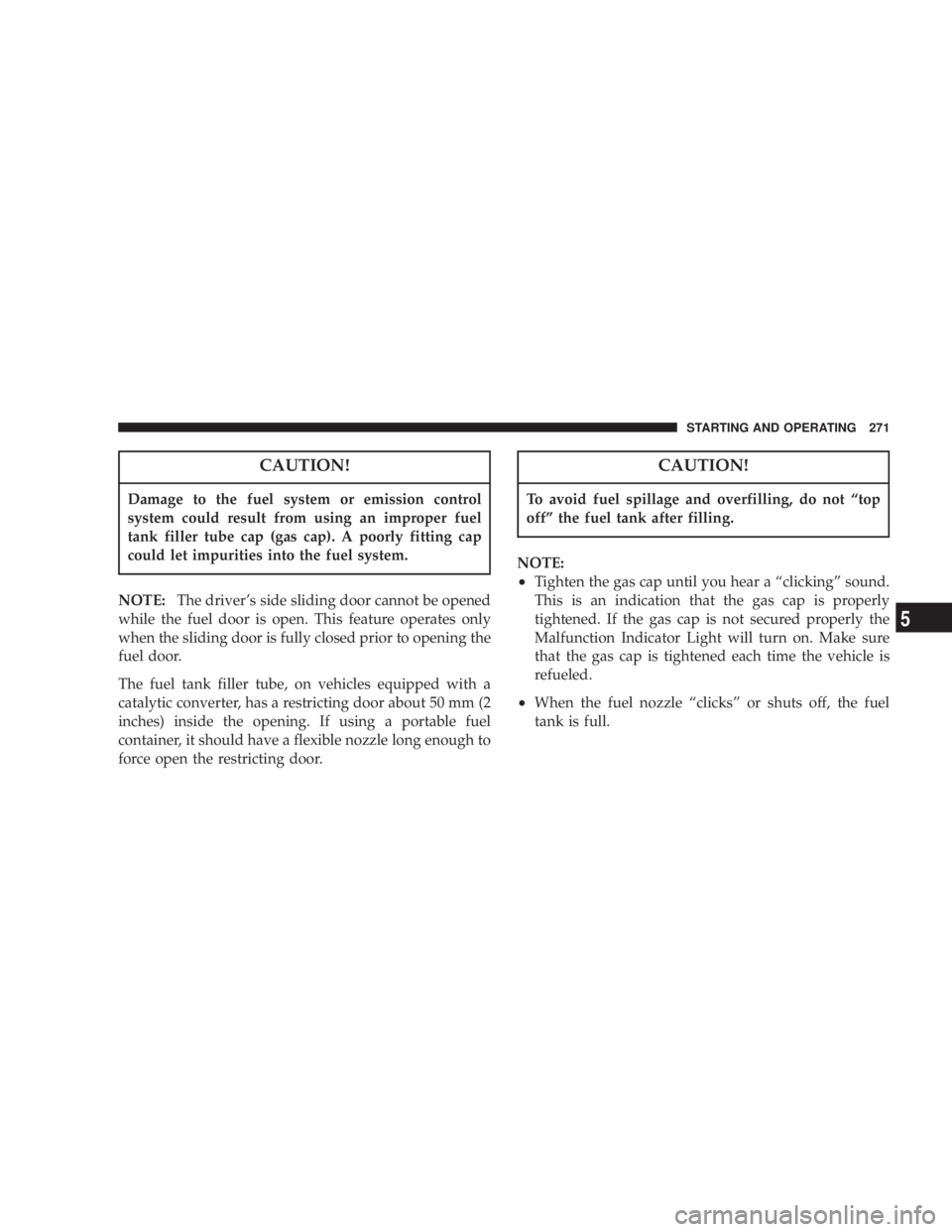
CAUTION!Damage to the fuel system or emission control
system could result from using an improper fuel
tank filler tube cap (gas cap). A poorly fitting cap
could let impurities into the fuel system.
NOTE: The driver's side sliding door cannot be opened
while the fuel door is open. This feature operates only
when the sliding door is fully closed prior to opening the
fuel door.
The fuel tank filler tube, on vehicles equipped with a
catalytic converter, has a restricting door about 50 mm (2
inches) inside the opening. If using a portable fuel
container, it should have a flexible nozzle long enough to
force open the restricting door. CAUTION!To avoid fuel spillage and overfilling, do not ªtop
offº the fuel tank after filling.
NOTE:
² Tighten the gas cap until you hear a ªclickingº sound.
This is an indication that the gas cap is properly
tightened. If the gas cap is not secured properly the
Malfunction Indicator Light will turn on. Make sure
that the gas cap is tightened each time the vehicle is
refueled.
² When the fuel nozzle ªclicksº or shuts off, the fuel
tank is full. STARTING AND OPERATING 271
5
Page 272 of 397
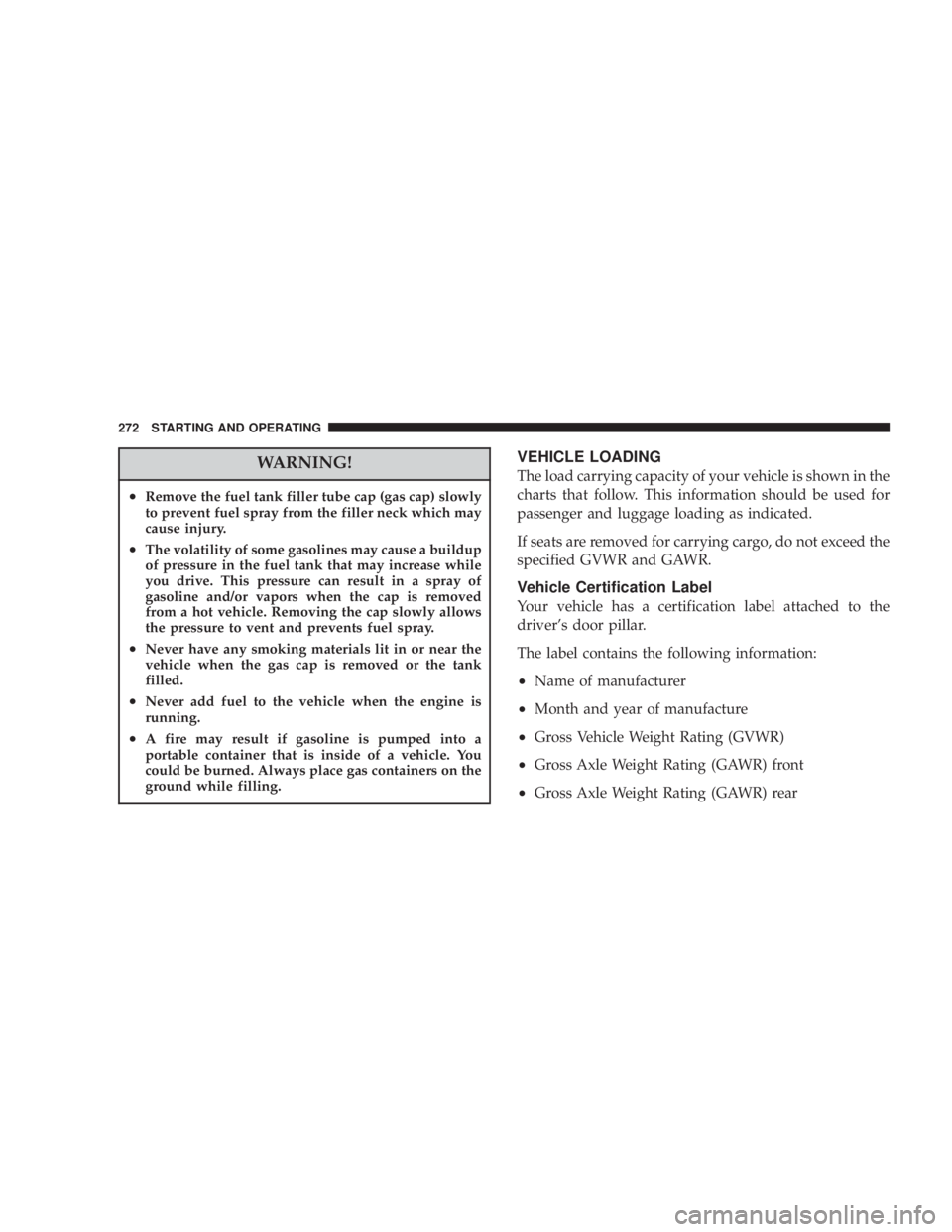
WARNING!² Remove the fuel tank filler tube cap (gas cap) slowly
to prevent fuel spray from the filler neck which may
cause injury.
² The volatility of some gasolines may cause a buildup
of pressure in the fuel tank that may increase while
you drive. This pressure can result in a spray of
gasoline and/or vapors when the cap is removed
from a hot vehicle. Removing the cap slowly allows
the pressure to vent and prevents fuel spray.
² Never have any smoking materials lit in or near the
vehicle when the gas cap is removed or the tank
filled.
² Never add fuel to the vehicle when the engine is
running.
² A fire may result if gasoline is pumped into a
portable container that is inside of a vehicle. You
could be burned. Always place gas containers on the
ground while filling. VEHICLE LOADING
The load carrying capacity of your vehicle is shown in the
charts that follow. This information should be used for
passenger and luggage loading as indicated.
If seats are removed for carrying cargo, do not exceed the
specified GVWR and GAWR.
Vehicle Certification Label
Your vehicle has a certification label attached to the
driver's door pillar.
The label contains the following information:
² Name of manufacturer
² Month and year of manufacture
² Gross Vehicle Weight Rating (GVWR)
² Gross Axle Weight Rating (GAWR) front
² Gross Axle Weight Rating (GAWR) rear272 STARTING AND OPERATING
Page 273 of 397
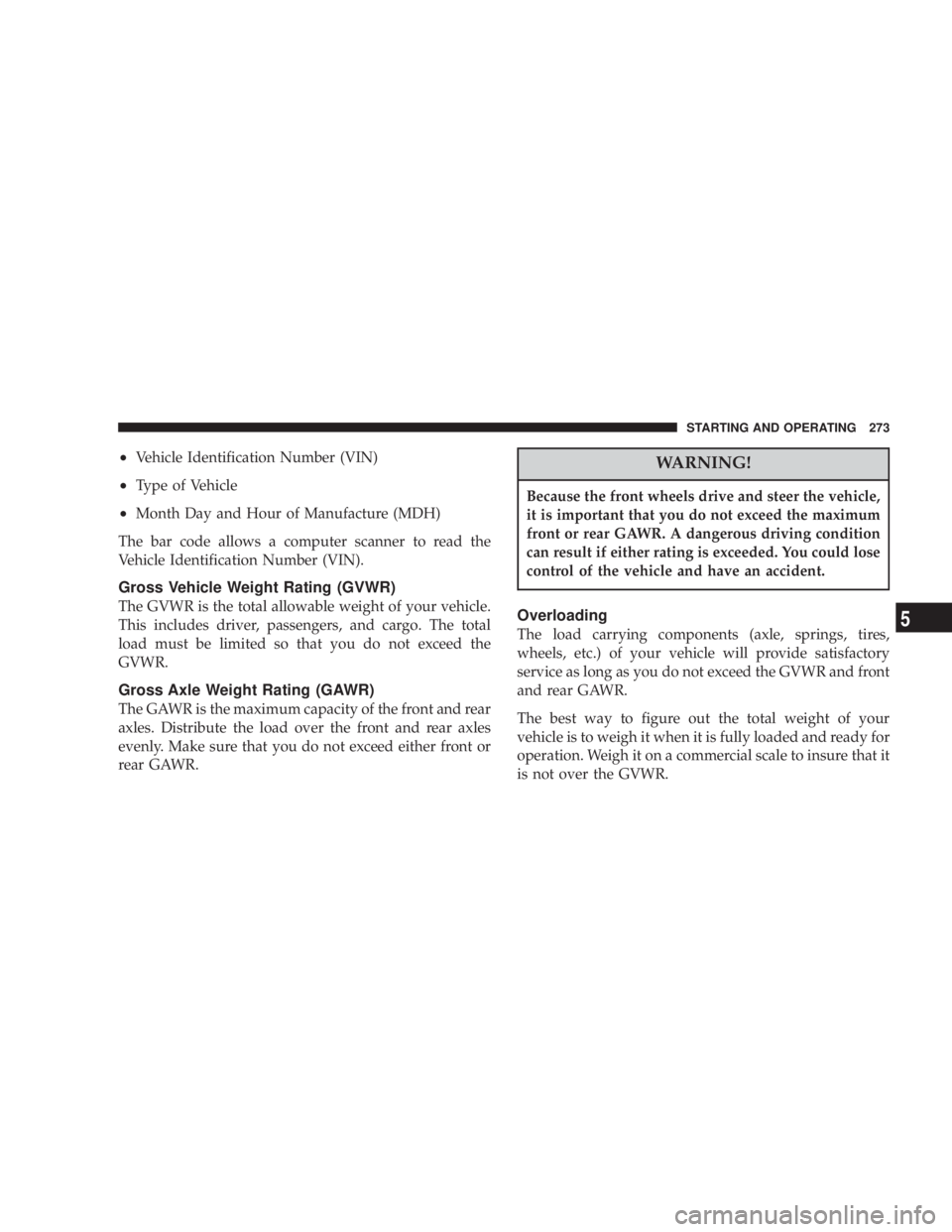
² Vehicle Identification Number (VIN)
² Type of Vehicle
² Month Day and Hour of Manufacture (MDH)
The bar code allows a computer scanner to read the
Vehicle Identification Number (VIN).
Gross Vehicle Weight Rating (GVWR)
The GVWR is the total allowable weight of your vehicle.
This includes driver, passengers, and cargo. The total
load must be limited so that you do not exceed the
GVWR.
Gross Axle Weight Rating (GAWR)
The GAWR is the maximum capacity of the front and rear
axles. Distribute the load over the front and rear axles
evenly. Make sure that you do not exceed either front or
rear GAWR. WARNING!Because the front wheels drive and steer the vehicle,
it is important that you do not exceed the maximum
front or rear GAWR. A dangerous driving condition
can result if either rating is exceeded. You could lose
control of the vehicle and have an accident.
Overloading
The load carrying components (axle, springs, tires,
wheels, etc.) of your vehicle will provide satisfactory
service as long as you do not exceed the GVWR and front
and rear GAWR.
The best way to figure out the total weight of your
vehicle is to weigh it when it is fully loaded and ready for
operation. Weigh it on a commercial scale to insure that it
is not over the GVWR. STARTING AND OPERATING 273
5
Page 274 of 397

Figure out the weight on the front and rear of the vehicle
separately. It is important that you distribute the load
evenly over the front and rear axles.
Overloading can cause potential safety hazards and
shorten useful service life. Heavier axles or suspension
components do not necessarily increase the vehicle's
GVWR.
Loading
To load your vehicle properly, first figure out its empty
weight, axle by axle and side by side. Store heavier items
down low and be sure you distribute their weight as
evenly as possible. Stow all loose items securely before
driving. If weighing the loaded vehicle shows that you
have exceeded either GAWR, but the total load is within
the specified GVWR, you must redistribute the weight.
Improper weight distribution can have an adverse effect
on the way your vehicle steers and handles and the way
the brakes operate. A loaded vehicle is shown in the illustration. Note that
neither the GVWR or the GAWR capacities have been
exceeded.274 STARTING AND OPERATING
Page 275 of 397
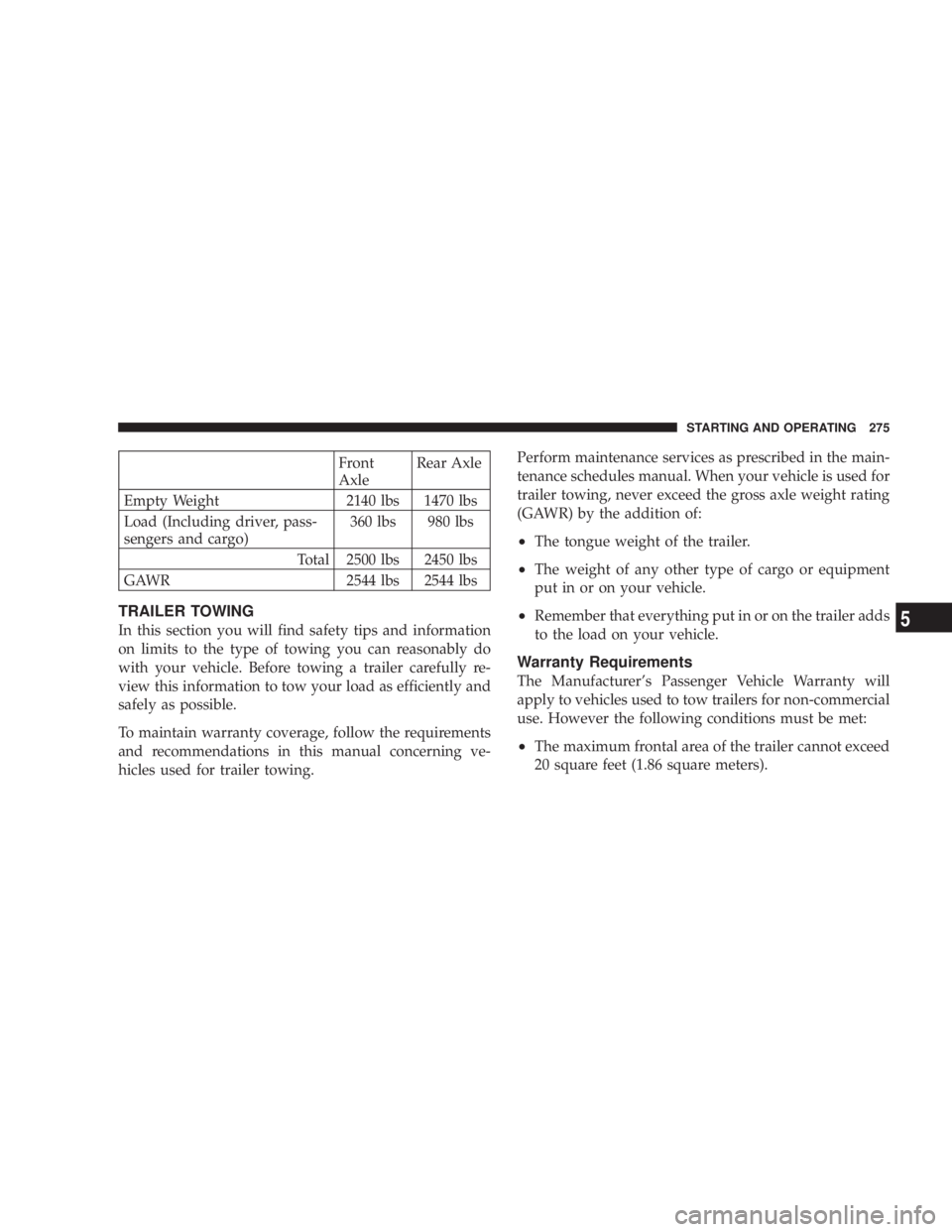
Front
Axle Rear Axle
Empty Weight 2140 lbs 1470 lbs
Load (Including driver, pass-
sengers and cargo) 360 lbs 980 lbs
Total 2500 lbs 2450 lbs
GAWR 2544 lbs 2544 lbs
TRAILER TOWING
In this section you will find safety tips and information
on limits to the type of towing you can reasonably do
with your vehicle. Before towing a trailer carefully re-
view this information to tow your load as efficiently and
safely as possible.
To maintain warranty coverage, follow the requirements
and recommendations in this manual concerning ve-
hicles used for trailer towing. Perform maintenance services as prescribed in the main-
tenance schedules manual. When your vehicle is used for
trailer towing, never exceed the gross axle weight rating
(GAWR) by the addition of:
² The tongue weight of the trailer.
² The weight of any other type of cargo or equipment
put in or on your vehicle.
² Remember that everything put in or on the trailer adds
to the load on your vehicle.
Warranty Requirements
The Manufacturer's Passenger Vehicle Warranty will
apply to vehicles used to tow trailers for non-commercial
use. However the following conditions must be met:
² The maximum frontal area of the trailer cannot exceed
20 square feet (1.86 square meters). STARTING AND OPERATING 275
5
Page 276 of 397
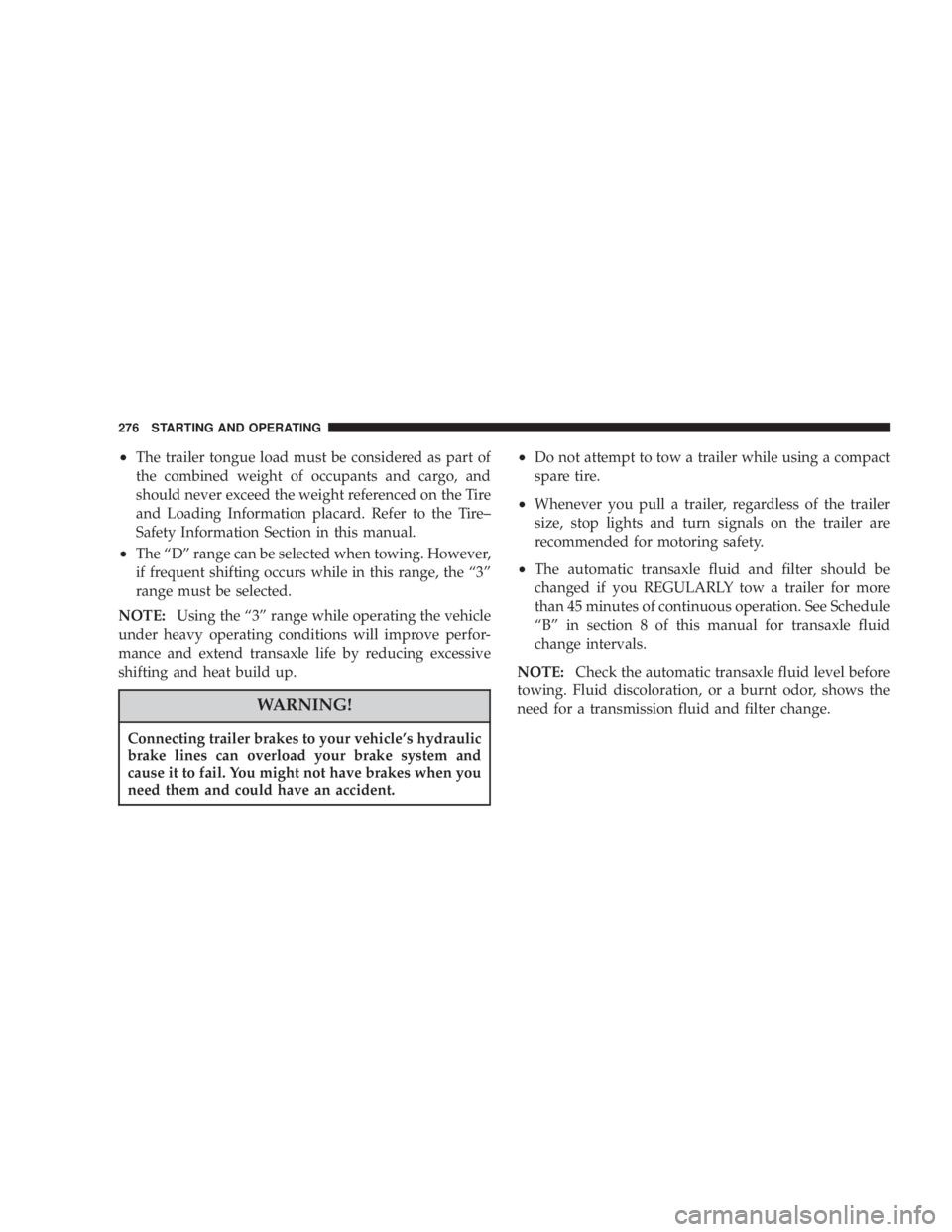
² The trailer tongue load must be considered as part of
the combined weight of occupants and cargo, and
should never exceed the weight referenced on the Tire
and Loading Information placard. Refer to the Tire±
Safety Information Section in this manual.
² The ªDº range can be selected when towing. However,
if frequent shifting occurs while in this range, the ª3º
range must be selected.
NOTE: Using the ª3º range while operating the vehicle
under heavy operating conditions will improve perfor-
mance and extend transaxle life by reducing excessive
shifting and heat build up.
WARNING!Connecting trailer brakes to your vehicle's hydraulic
brake lines can overload your brake system and
cause it to fail. You might not have brakes when you
need them and could have an accident. ² Do not attempt to tow a trailer while using a compact
spare tire.
² Whenever you pull a trailer, regardless of the trailer
size, stop lights and turn signals on the trailer are
recommended for motoring safety.
² The automatic transaxle fluid and filter should be
changed if you REGULARLY tow a trailer for more
than 45 minutes of continuous operation. See Schedule
ªBº in section 8 of this manual for transaxle fluid
change intervals.
NOTE: Check the automatic transaxle fluid level before
towing. Fluid discoloration, or a burnt odor, shows the
need for a transmission fluid and filter change.276 STARTING AND OPERATING
Page 277 of 397
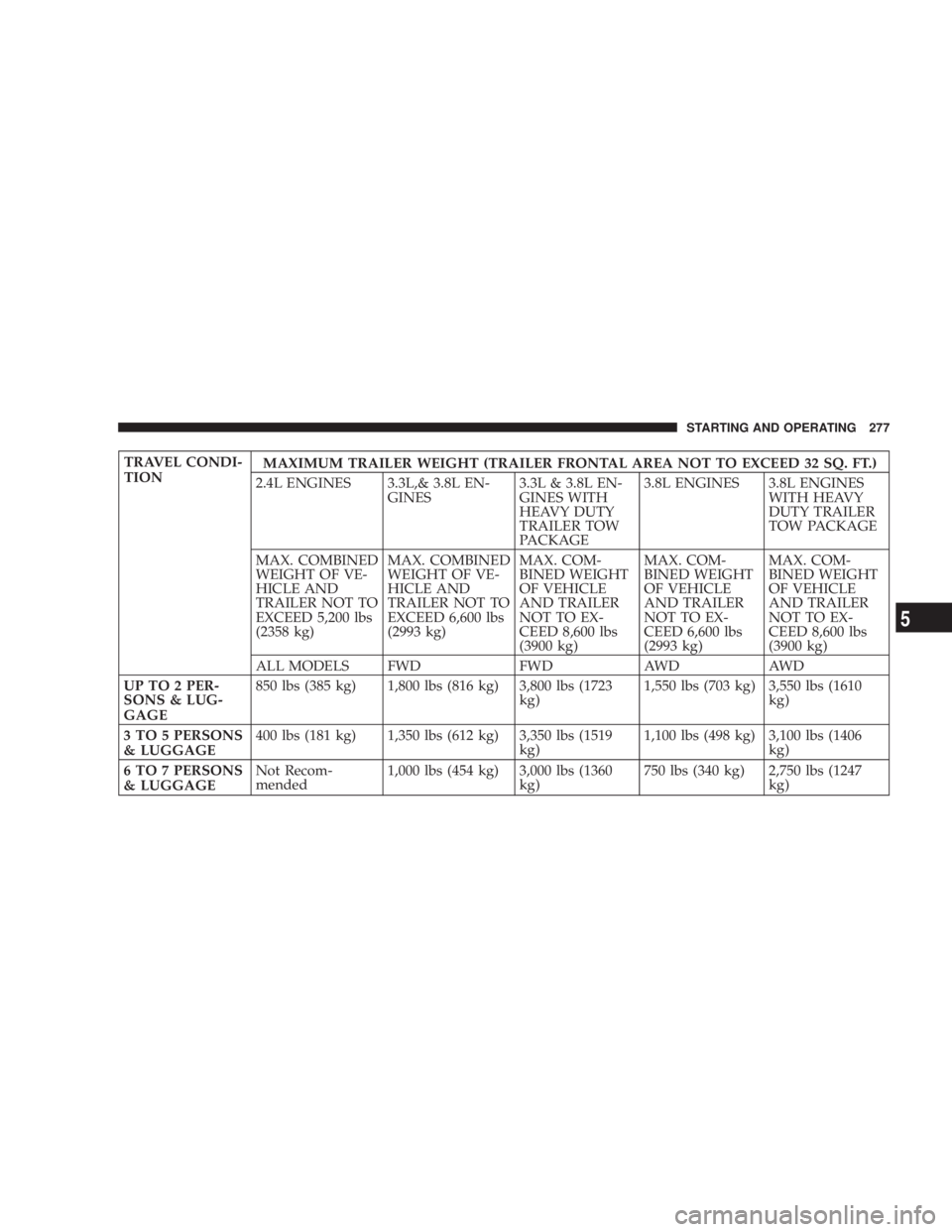
TRAVEL CONDI-
TION MAXIMUM TRAILER WEIGHT (TRAILER FRONTAL AREA NOT TO EXCEED 32 SQ. FT.)
2.4L ENGINES 3.3L,& 3.8L EN-
GINES 3.3L & 3.8L EN-
GINES WITH
HEAVY DUTY
TRAILER TOW
PACKAGE 3.8L ENGINES 3.8L ENGINES
WITH HEAVY
DUTY TRAILER
TOW PACKAGE
MAX. COMBINED
WEIGHT OF VE-
HICLE AND
TRAILER NOT TO
EXCEED 5,200 lbs
(2358 kg) MAX. COMBINED
WEIGHT OF VE-
HICLE AND
TRAILER NOT TO
EXCEED 6,600 lbs
(2993 kg) MAX. COM-
BINED WEIGHT
OF VEHICLE
AND TRAILER
NOT TO EX-
CEED 8,600 lbs
(3900 kg) MAX. COM-
BINED WEIGHT
OF VEHICLE
AND TRAILER
NOT TO EX-
CEED 6,600 lbs
(2993 kg) MAX. COM-
BINED WEIGHT
OF VEHICLE
AND TRAILER
NOT TO EX-
CEED 8,600 lbs
(3900 kg)
ALL MODELS FWD FWD AWD AWD
UP TO 2 PER-
SONS & LUG-
GAGE 850 lbs (385 kg) 1,800 lbs (816 kg) 3,800 lbs (1723
kg) 1,550 lbs (703 kg) 3,550 lbs (1610
kg)
3 TO 5 PERSONS
& LUGGAGE 400 lbs (181 kg) 1,350 lbs (612 kg) 3,350 lbs (1519
kg) 1,100 lbs (498 kg) 3,100 lbs (1406
kg)
6 TO 7 PERSONS
& LUGGAGE Not Recom-
mended 1,000 lbs (454 kg) 3,000 lbs (1360
kg) 750 lbs (340 kg) 2,750 lbs (1247
kg) STARTING AND OPERATING 277
5
Page 278 of 397
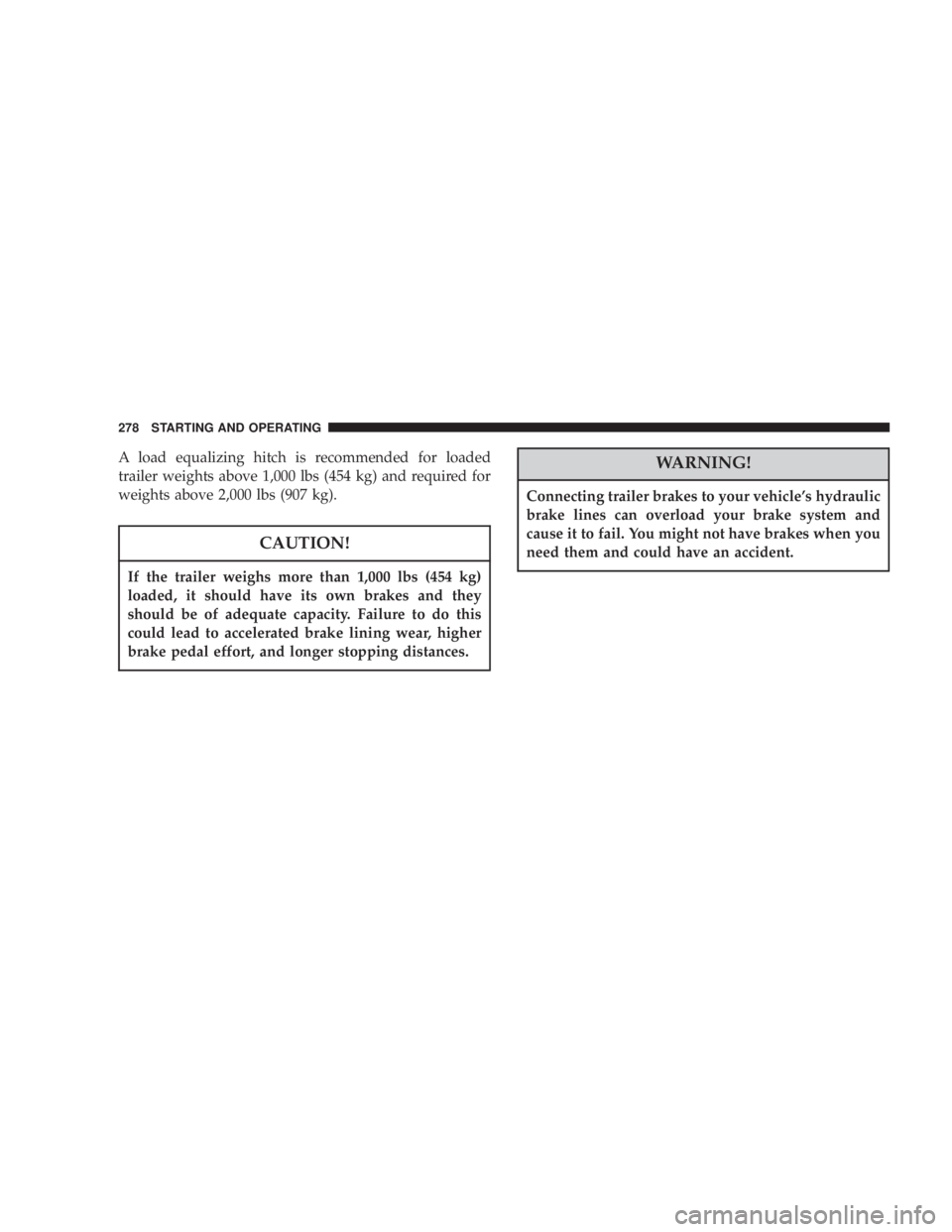
A load equalizing hitch is recommended for loaded
trailer weights above 1,000 lbs (454 kg) and required for
weights above 2,000 lbs (907 kg).
CAUTION!If the trailer weighs more than 1,000 lbs (454 kg)
loaded, it should have its own brakes and they
should be of adequate capacity. Failure to do this
could lead to accelerated brake lining wear, higher
brake pedal effort, and longer stopping distances. WARNING!Connecting trailer brakes to your vehicle's hydraulic
brake lines can overload your brake system and
cause it to fail. You might not have brakes when you
need them and could have an accident.278 STARTING AND OPERATING
Page 279 of 397
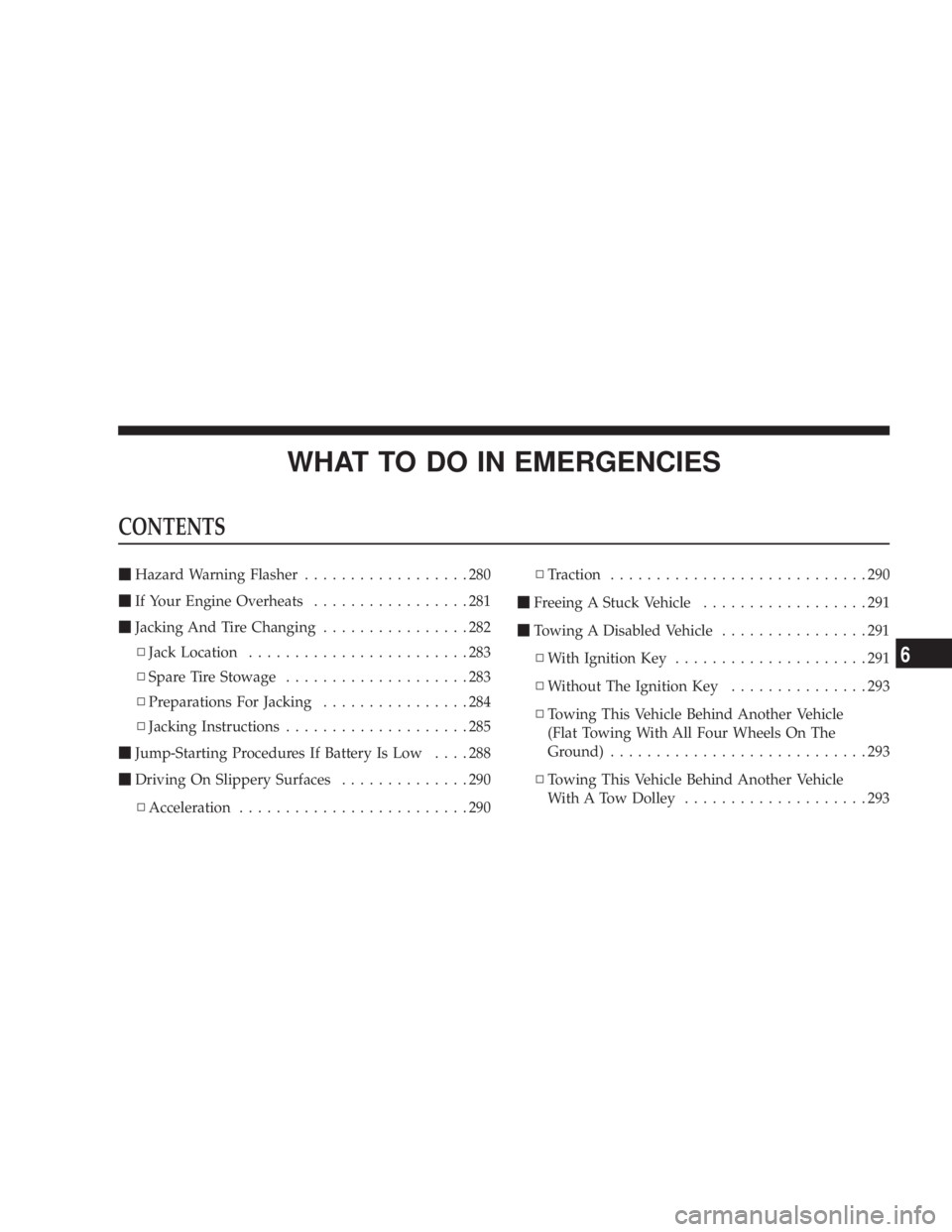
WHAT TO DO IN EMERGENCIESCONTENTS m Hazard Warning Flasher ..................280
m If Your Engine Overheats .................281
m Jacking And Tire Changing ................282
N Jack Location ........................283
N Spare Tire Stowage ....................283
N Preparations For Jacking ................284
N Jacking Instructions ....................285
m Jump-Starting Procedures If Battery Is Low ....288
m Driving On Slippery Surfaces ..............290
N Acceleration .........................290 N Traction ............................290
m Freeing A Stuck Vehicle ..................291
m Towing A Disabled Vehicle ................291
N With Ignition Key .....................291
N Without The Ignition Key ...............293
N Towing This Vehicle Behind Another Vehicle
(Flat Towing With All Four Wheels On The
Ground) ............................293
N Towing This Vehicle Behind Another Vehicle
With A Tow Dolley ....................293
6
Page 280 of 397
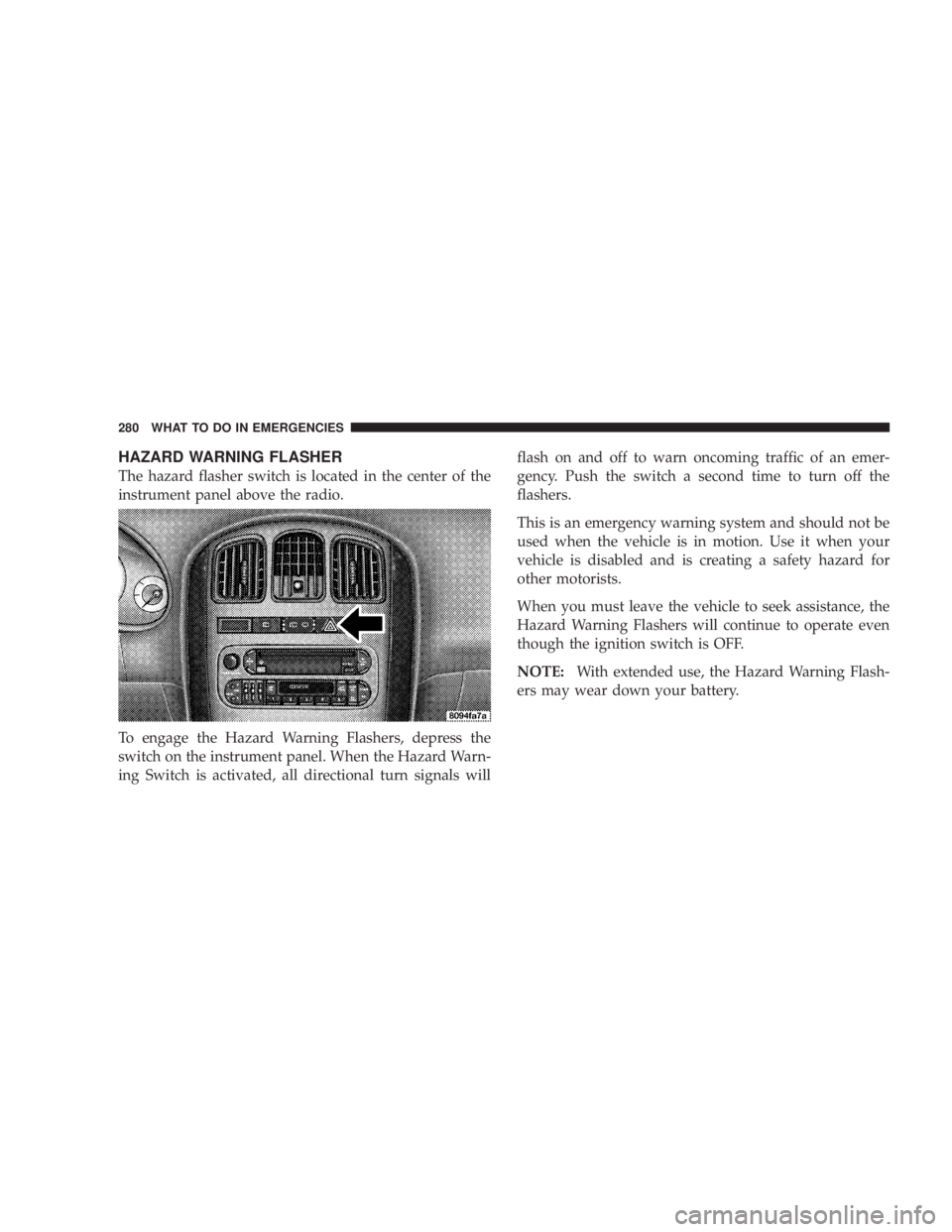
HAZARD WARNING FLASHER
The hazard flasher switch is located in the center of the
instrument panel above the radio.
To engage the Hazard Warning Flashers, depress the
switch on the instrument panel. When the Hazard Warn-
ing Switch is activated, all directional turn signals will flash on and off to warn oncoming traffic of an emer-
gency. Push the switch a second time to turn off the
flashers.
This is an emergency warning system and should not be
used when the vehicle is in motion. Use it when your
vehicle is disabled and is creating a safety hazard for
other motorists.
When you must leave the vehicle to seek assistance, the
Hazard Warning Flashers will continue to operate even
though the ignition switch is OFF.
NOTE: With extended use, the Hazard Warning Flash-
ers may wear down your battery.280 WHAT TO DO IN EMERGENCIES